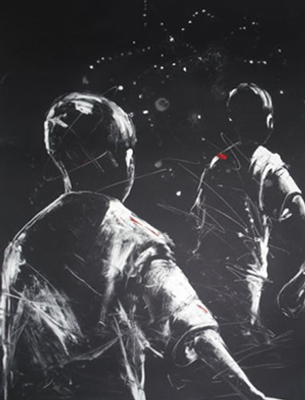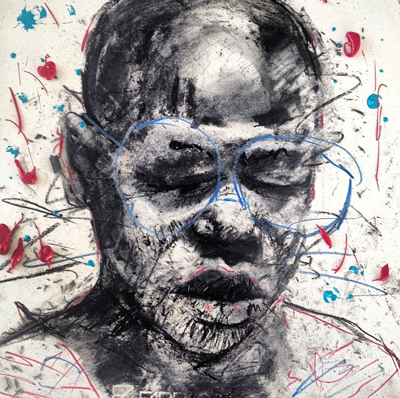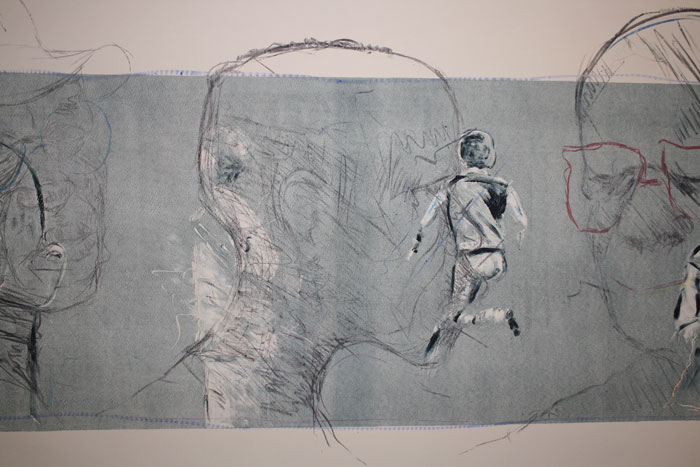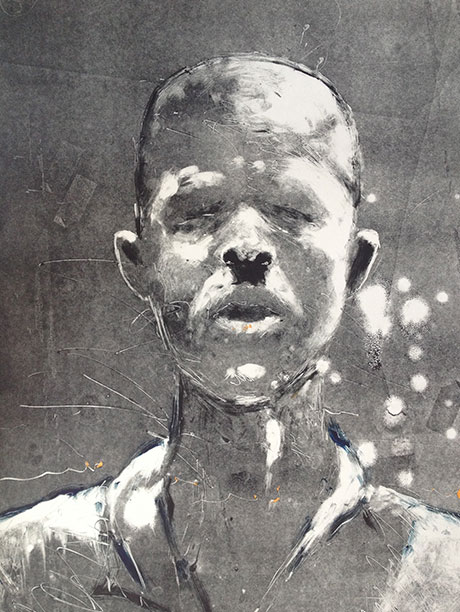
Nelson Makamo, 1982.
About:
Nelson Makamo was born in a small town of Nylstroom (now Modimolle), Limpopo province, in 1982. Makamo moved to Johannesburg to join the Artist Proof Studio in January 2003 where he studied for 3 years and worked for another 2 years as sales representative and curator of the gallery. He was awarded a bursary from Johnson and Johnson and the Pinpoint one Human Resources Scholarship in 2005. Makamo has exhibited in group and solo exhibitions in South Africa, France, Italy, America, Netherlands, Amsterdam and Scotland. His first solo exhibition, Walk with Me, was held at the Obert Contemporary Gallery in Melrose Arch, Johannesburg. His most notable group exhibition was alongside established South African artists in Ten Years of Printmaking: David Krut Print Studio in 2006. Invited artists included David Koloane, Colbert Mashile, Deborah Bell and William Kentridge.
Makomo’s commissioned works include a series of Lekas Lekalakala’s portraits for a chamber Lekalakala opened at Potgietersrus (now Mokopane). Other commissioned works include portraits of Nelson Mandela, Oliver Tambo, and Walter Sisulu for Matasis Investment Holdings. Matasis was named after the above mentioned political figures. Makamo’s work forms part of a few collections such as those of fashion mogul Georgio Armani and musician Annie Lenox.
Makamo was Art South Africa’s Seventh Bright Young Thing and has recently won the Klipdrift Gold Artists Award. In 2010 he had numerous publications by True love Magazine, Tageblatt as well as the Mail and Guardian. In 2011 he exhibited in the Reunion Biennale of Contemporary Art, in the same year he was commissioned by the BRT (Reavaya) to install his artwork in one of the bus stations. Makamo participated as one of the artists in the 21 Year Celebration of the Artists Proof Studio at the Johannesburg Art Gallery. Makamo currently works as a fulltime artist in Johannesburg with a studio at August House.
Story Telling: Reflections
Before Sunset.
I reflect back on distant memories, especially my childhood memories. We experience change in different ways, even though some things stay the same. I played football barefoot, not because of circumstance, as most people might think, but because of choice. When I was young, the main purpose was to go and play football. I am constantly reminded of the freedom I had. It draws a barrier line between being a child and being an adult. As a child, we have too much freedom, we hardly have any responsibilities. Now, as an adult, I think of the risks attached to playing football barefoot such as getting cut by bottles. My work can sometimes be read as pessimistic. In every joy, there is sadness. Even though you may play as a child, you reach a stage where you have responsibilities. I am not necessarily afraid of responsibilities. However, as a child you tend to unconsciously run away from them. When you are playing, that is all you care about. You do not want your mother to call you inside to wash your socks or polish your shoes. You just want to play. But, unfortunately, that playful time ends at some point. You do indeed become an adult.
Untitled.
Subject Matter: Portraiture
I do a lot of portraits. There is something that draws to me to facial expressions. They reflect so much about a person their mood, their character etc. That is one of the ways that you can know someone. We can discern what relationships we have with people through our body language, and out of all of these, therefore determine the kinds of relationships I have with them.
Untitled, 2011.
Subject Matter: Young Boys
My subject matter consists of numerous young boys, as well as young male adults. This is because they reflect a stage in life which I have passed through. So, I feel that I can reflect better on their issues as I have experienced them. I give a lot of wisdom to the young boys that I portray. This can be seen in their facial expressions, which I believe tells a lot about a person. However, I try not to make my work too personal. Whatever I share could have been experienced by someone else. As a result, anybody can relate to my work. I am very proud of that. It opens the work to interpretation.
Untitled.
Movement
In my work, I reflect on the movement of culture amongst the youth living in and around the city. What I mean by this is that we adopt different cultures that pertain to our different ages, and we are constantly performing those cultures. I also explore the ability to pass through different stages of life. My work does not represent a certain group of people, it bridges many. I use emotive mark making which symbolizes the movement I was referring to earlier. Lines are the most important thing in my work. I use line to give my work life and to represent motion. (text Everard Read Gallery, Johannesburg)





